Abstract
1. The subtypes of alpha 1-adrenoceptor mediating contractions to exogenous noradrenaline (NA) in rat aorta have been examined in both biochemical and functional studies. 2. Incubation of rat aortic membranes with the irreversible alpha 1B-adrenoceptor antagonist, chloroethylclonidine (CEC: 10 microM) did not change the KD of [3H]-prazosin binding in comparison to untreated membranes, but reduced by 88% the total number of binding sites (Bmax). 3. Contractions of rat aortic strips to NA after CEC (50 microM for 30 min) incubation followed by repetitive washing, showed a marked shift in the potency of NA and a partial reduction in the maximum response. The residual contractions to NA after CEC incubation were not affected by prazosin (10 nM). 4. The competitive antagonists prazosin, terazosin, (R)-YM-12617, phentolamine, 5-methylurapidil and spiperone inhibited contractions to NA with estimated pA2 values of 9.85, 8.54, 9.34, 7.71, 7.64 and 8.41, respectively. 5. The affinity of the same antagonists for the alpha 1A- and alpha 1B- adrenoceptors was evaluated by utilizing membranes from rat hippocampus pretreated with CEC, and rat liver, respectively. 5-Methylurapidil and phentolamine were confirmed as selective for the alpha 1A-adrenoceptors, whereas spiperone was alpha 1B-selective. 6. A significant correlation was found between the pA2 values of the alpha 1-adrenoceptor antagonists tested and their affinity for the alpha 1B-adrenoceptor subtype, but not for the alpha 1A-subtype. 7. In conclusion, these findings indicate that in rat aorta most of the contraction is mediated by alpha 1B-adrenoceptors, and that the potency (pA2) of an antagonist in this tissue should be related to its antagonistic effect on this subtype of the alpha 1-adrenoceptor population.
Full text
PDF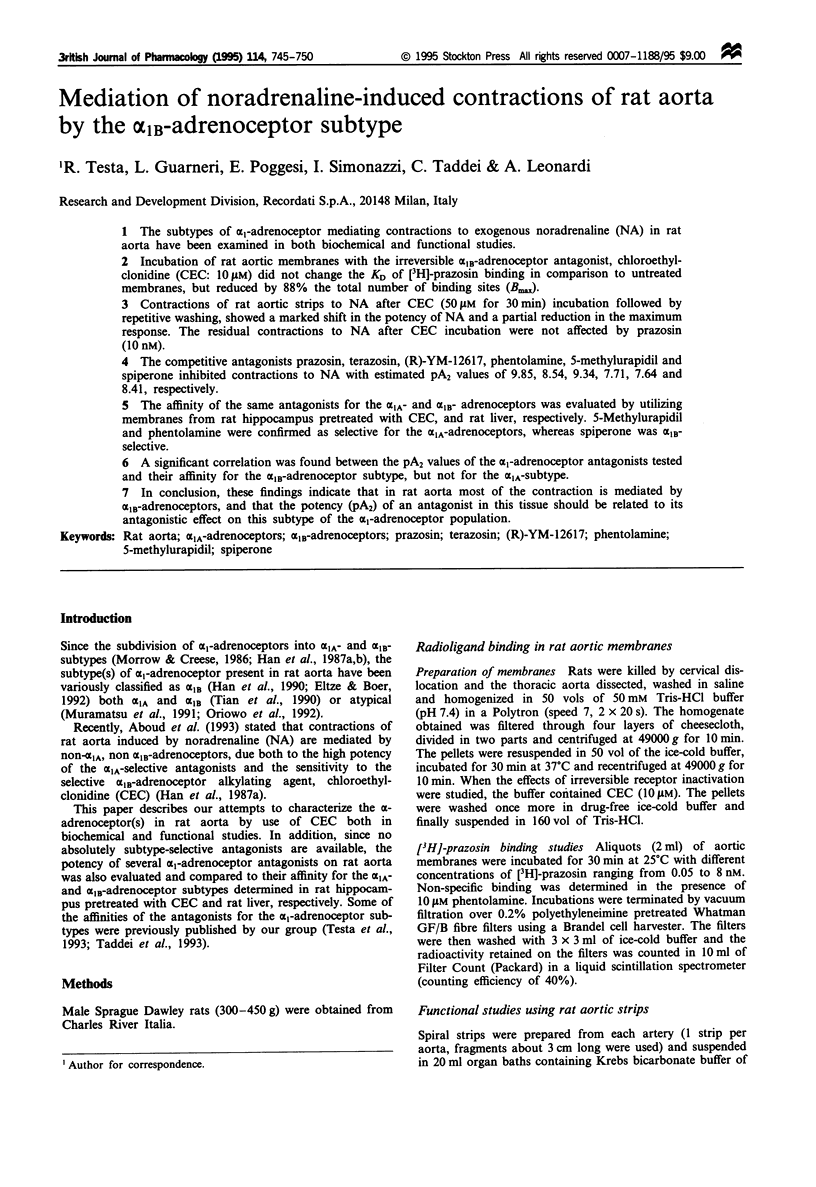
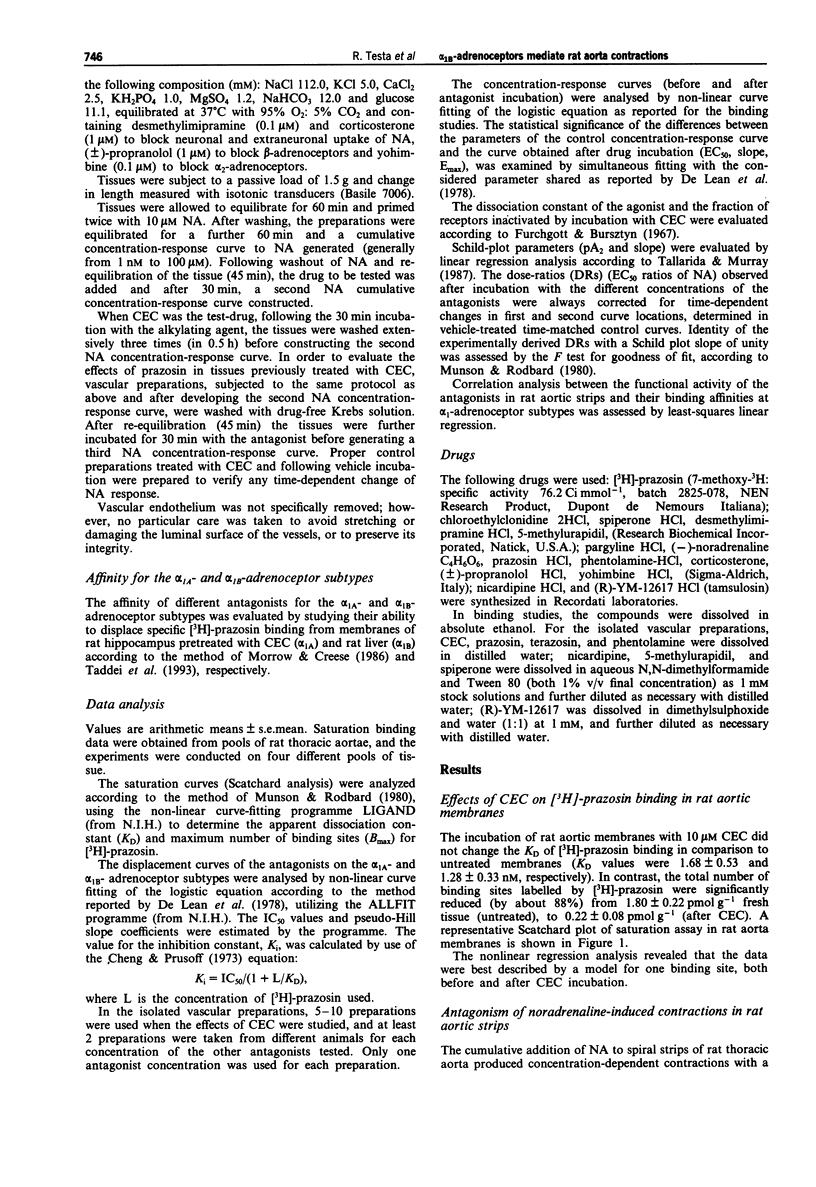
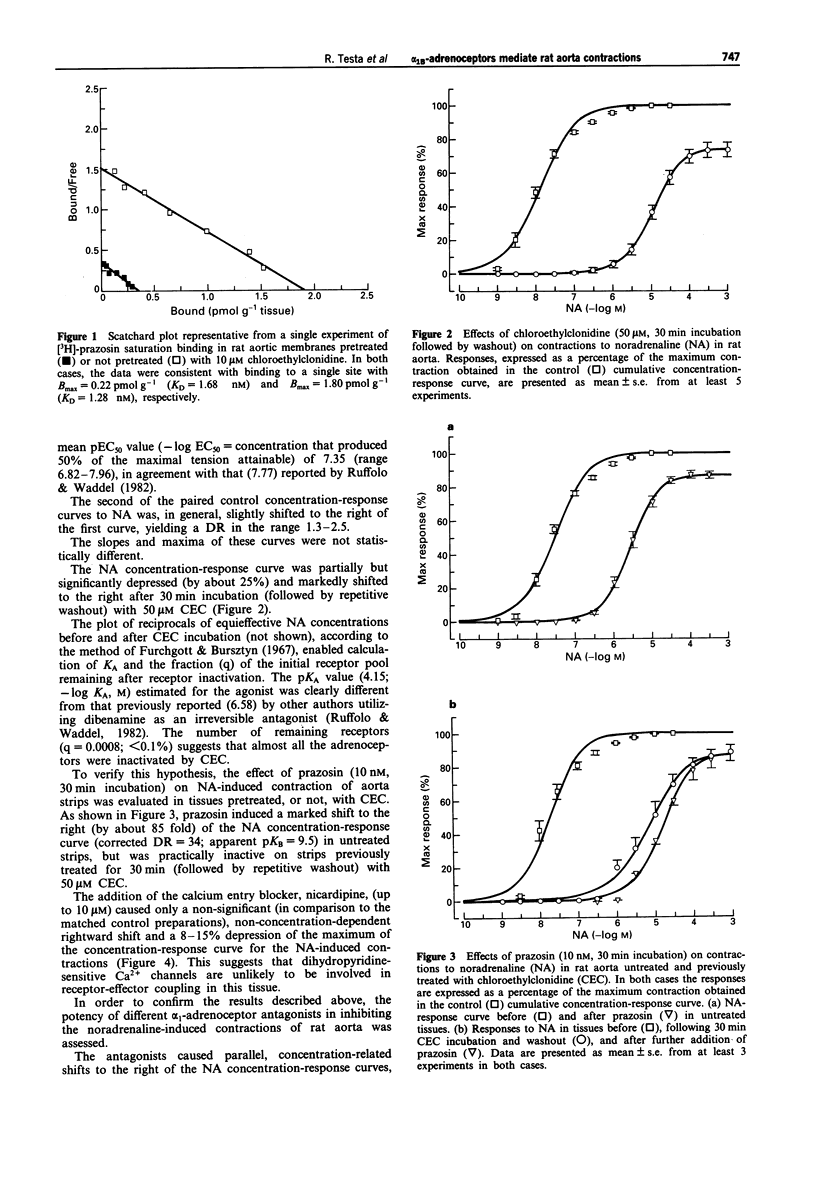

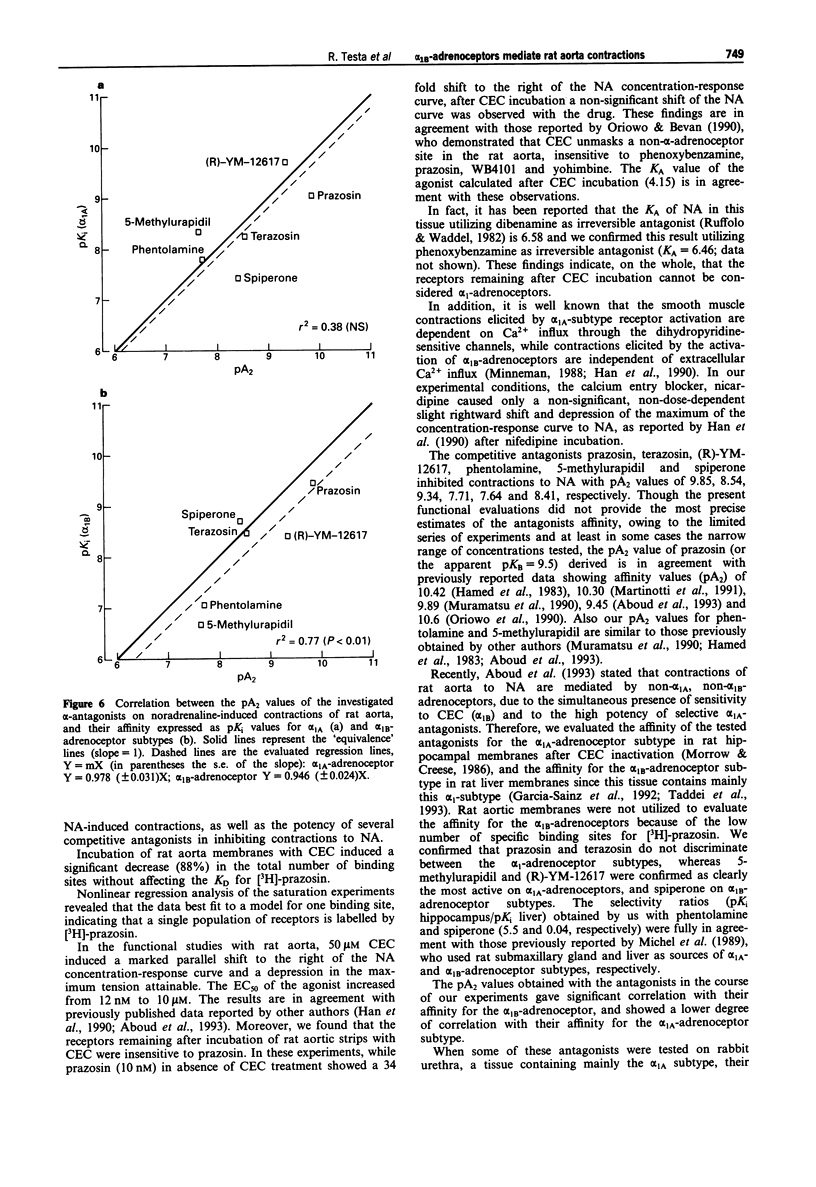
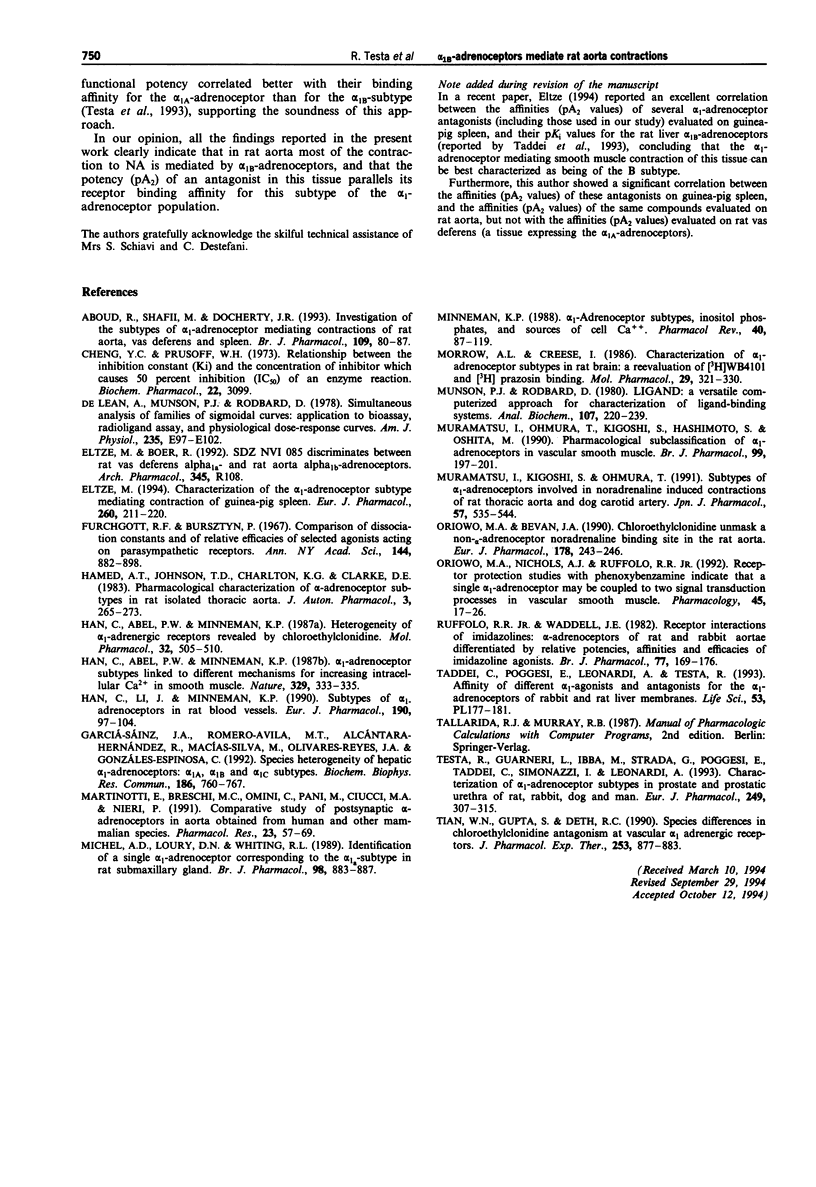
Selected References
These references are in PubMed. This may not be the complete list of references from this article.
- Aboud R., Shafii M., Docherty J. R. Investigation of the subtypes of alpha 1-adrenoceptor mediating contractions of rat aorta, vas deferens and spleen. Br J Pharmacol. 1993 May;109(1):80–87. doi: 10.1111/j.1476-5381.1993.tb13534.x. [DOI] [PMC free article] [PubMed] [Google Scholar]
- Cheng Y., Prusoff W. H. Relationship between the inhibition constant (K1) and the concentration of inhibitor which causes 50 per cent inhibition (I50) of an enzymatic reaction. Biochem Pharmacol. 1973 Dec 1;22(23):3099–3108. doi: 10.1016/0006-2952(73)90196-2. [DOI] [PubMed] [Google Scholar]
- DeLean A., Munson P. J., Rodbard D. Simultaneous analysis of families of sigmoidal curves: application to bioassay, radioligand assay, and physiological dose-response curves. Am J Physiol. 1978 Aug;235(2):E97–102. doi: 10.1152/ajpendo.1978.235.2.E97. [DOI] [PubMed] [Google Scholar]
- Eltze M. Characterization of the alpha 1-adrenoceptor subtype mediating contraction of guinea-pig spleen. Eur J Pharmacol. 1994 Aug 1;260(2-3):211–220. doi: 10.1016/0014-2999(94)90339-5. [DOI] [PubMed] [Google Scholar]
- García-Sáinz J. A., Romero-Avila M. T., Alcántara Hernández R., Macias-Silva M., Olivares-Reyes A., González-Espinosa C. Species heterogeneity of hepatic alpha 1-adrenoceptors: alpha 1A-, alpha 1B- and alpha 1C-subtypes. Biochem Biophys Res Commun. 1992 Jul 31;186(2):760–767. doi: 10.1016/0006-291x(92)90811-x. [DOI] [PubMed] [Google Scholar]
- Hamed A. T., Johnson T. D., Charlton K. G., Clarke D. E. Pharmacological characterization of alpha-adrenoreceptor subtypes in rat isolated thoracic aorta. J Auton Pharmacol. 1983 Dec;3(4):265–273. doi: 10.1111/j.1474-8673.1983.tb00544.x. [DOI] [PubMed] [Google Scholar]
- Han C., Abel P. W., Minneman K. P. Alpha 1-adrenoceptor subtypes linked to different mechanisms for increasing intracellular Ca2+ in smooth muscle. Nature. 1987 Sep 24;329(6137):333–335. doi: 10.1038/329333a0. [DOI] [PubMed] [Google Scholar]
- Han C., Abel P. W., Minneman K. P. Heterogeneity of alpha 1-adrenergic receptors revealed by chlorethylclonidine. Mol Pharmacol. 1987 Oct;32(4):505–510. [PubMed] [Google Scholar]
- Han C., Li J., Minneman K. P. Subtypes of alpha 1-adrenoceptors in rat blood vessels. Eur J Pharmacol. 1990 Nov 6;190(1-2):97–104. doi: 10.1016/0014-2999(90)94116-f. [DOI] [PubMed] [Google Scholar]
- Martinotti E., Breschi M. C., Omini C., Pani M., Ciucci M. A., Nieri P. Comparative study of postsynaptic alpha-adrenoceptors in aorta obtained from human and other mammalian species. Pharmacol Res. 1991 Jan;23(1):57–69. doi: 10.1016/s1043-6618(05)80107-0. [DOI] [PubMed] [Google Scholar]
- Michel A. D., Loury D. N., Whiting R. L. Identification of a single alpha 1-adrenoceptor corresponding to the alpha 1A-subtype in rat submaxillary gland. Br J Pharmacol. 1989 Nov;98(3):883–889. doi: 10.1111/j.1476-5381.1989.tb14617.x. [DOI] [PMC free article] [PubMed] [Google Scholar]
- Minneman K. P. Alpha 1-adrenergic receptor subtypes, inositol phosphates, and sources of cell Ca2+. Pharmacol Rev. 1988 Jun;40(2):87–119. [PubMed] [Google Scholar]
- Morrow A. L., Creese I. Characterization of alpha 1-adrenergic receptor subtypes in rat brain: a reevaluation of [3H]WB4104 and [3H]prazosin binding. Mol Pharmacol. 1986 Apr;29(4):321–330. [PubMed] [Google Scholar]
- Munson P. J., Rodbard D. Ligand: a versatile computerized approach for characterization of ligand-binding systems. Anal Biochem. 1980 Sep 1;107(1):220–239. doi: 10.1016/0003-2697(80)90515-1. [DOI] [PubMed] [Google Scholar]
- Muramatsu I., Kigoshi S., Ohmura T. Subtypes of alpha 1-adrenoceptors involved in noradrenaline-induced contractions of rat thoracic aorta and dog carotid artery. Jpn J Pharmacol. 1991 Dec;57(4):535–544. doi: 10.1254/jjp.57.535. [DOI] [PubMed] [Google Scholar]
- Muramatsu I., Ohmura T., Kigoshi S., Hashimoto S., Oshita M. Pharmacological subclassification of alpha 1-adrenoceptors in vascular smooth muscle. Br J Pharmacol. 1990 Jan;99(1):197–201. doi: 10.1111/j.1476-5381.1990.tb14678.x. [DOI] [PMC free article] [PubMed] [Google Scholar]
- Oriowo M. A., Bevan J. A. Chloroethylclonidine unmasks a non-alpha-adrenoceptor noradrenaline binding site in the rat aorta. Eur J Pharmacol. 1990 Mar 20;178(2):243–246. doi: 10.1016/0014-2999(90)90482-l. [DOI] [PubMed] [Google Scholar]
- Oriowo M. A., Nichols A. J., Ruffolo R. R., Jr Receptor protection studies with phenoxybenzamine indicate that a single alpha 1-adrenoceptor may be coupled to two signal transduction processes in vascular smooth muscle. Pharmacology. 1992;45(1):17–26. doi: 10.1159/000138968. [DOI] [PubMed] [Google Scholar]
- Ruffolo R. R., Jr, Waddell J. E. Receptor interactions of imidazolines: alpha-adrenoceptors of rat and rabbit aortae differentiated by relative potencies, affinities and efficacies of imidazoline agonists. Br J Pharmacol. 1982 Sep;77(1):169–176. doi: 10.1111/j.1476-5381.1982.tb09283.x. [DOI] [PMC free article] [PubMed] [Google Scholar]
- Taddei C., Poggesi E., Leonardi A., Testa R. Affinity of different alpha 1-agonists and antagonists for the alpha 1-adrenoceptors of rabbit and rat liver membranes. Life Sci. 1993;53(12):PL177–PL181. doi: 10.1016/0024-3205(93)90127-o. [DOI] [PubMed] [Google Scholar]
- Testa R., Guarneri L., Ibba M., Strada G., Poggesi E., Taddei C., Simonazzi I., Leonardi A. Characterization of alpha 1-adrenoceptor subtypes in prostate and prostatic urethra of rat, rabbit, dog and man. Eur J Pharmacol. 1993 Nov 16;249(3):307–315. doi: 10.1016/0014-2999(93)90527-o. [DOI] [PubMed] [Google Scholar]
- Tian W. N., Gupta S., Deth R. C. Species differences in chlorethylclonidine antagonism at vascular alpha-1 adrenergic receptors. J Pharmacol Exp Ther. 1990 May;253(2):877–883. [PubMed] [Google Scholar]


